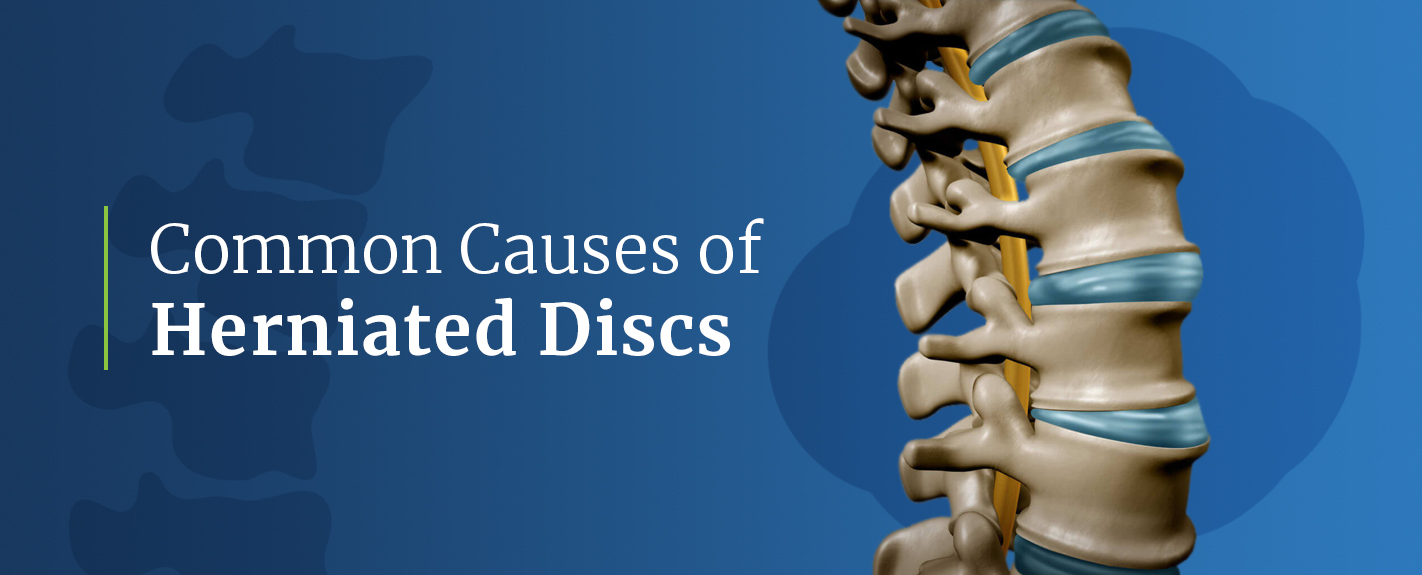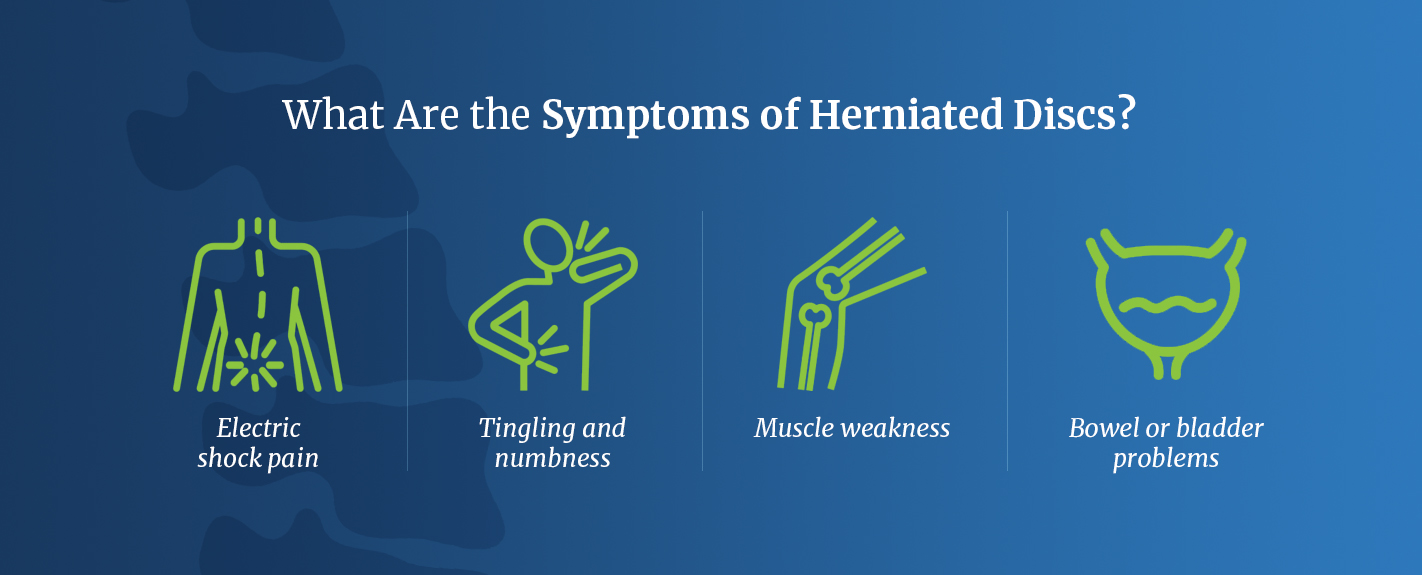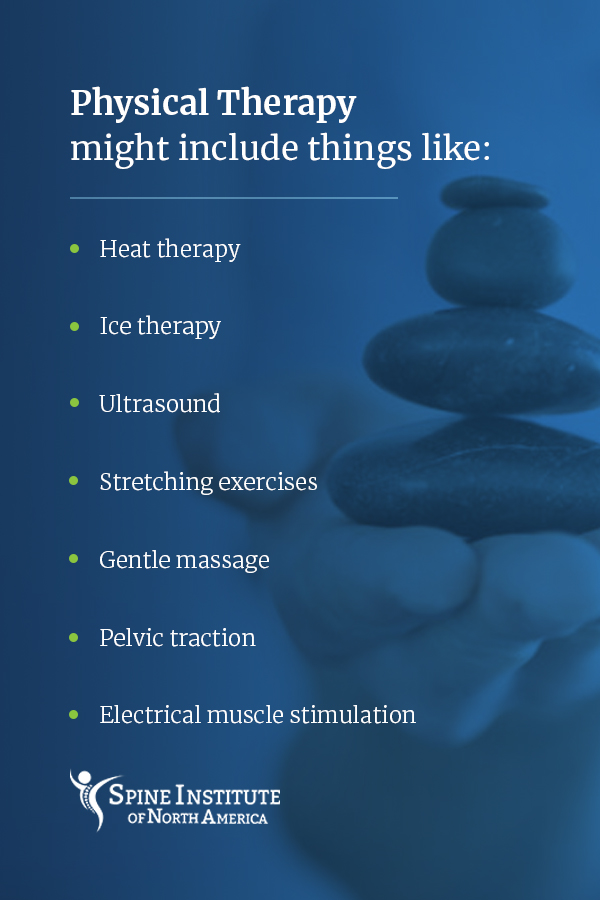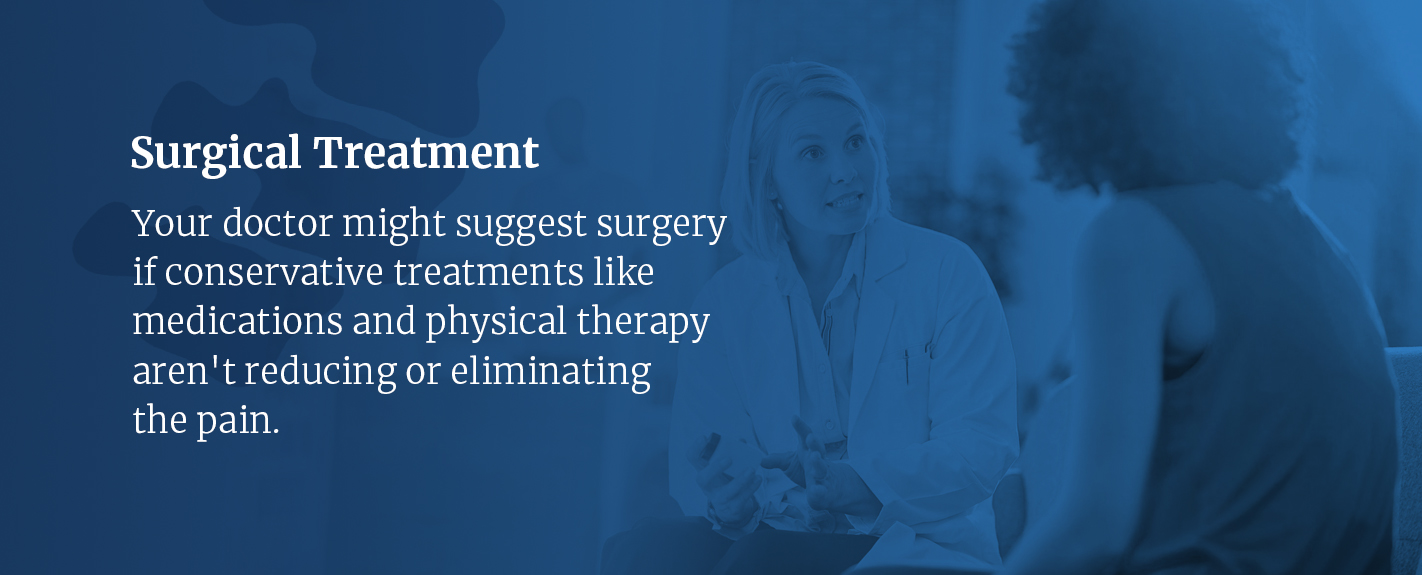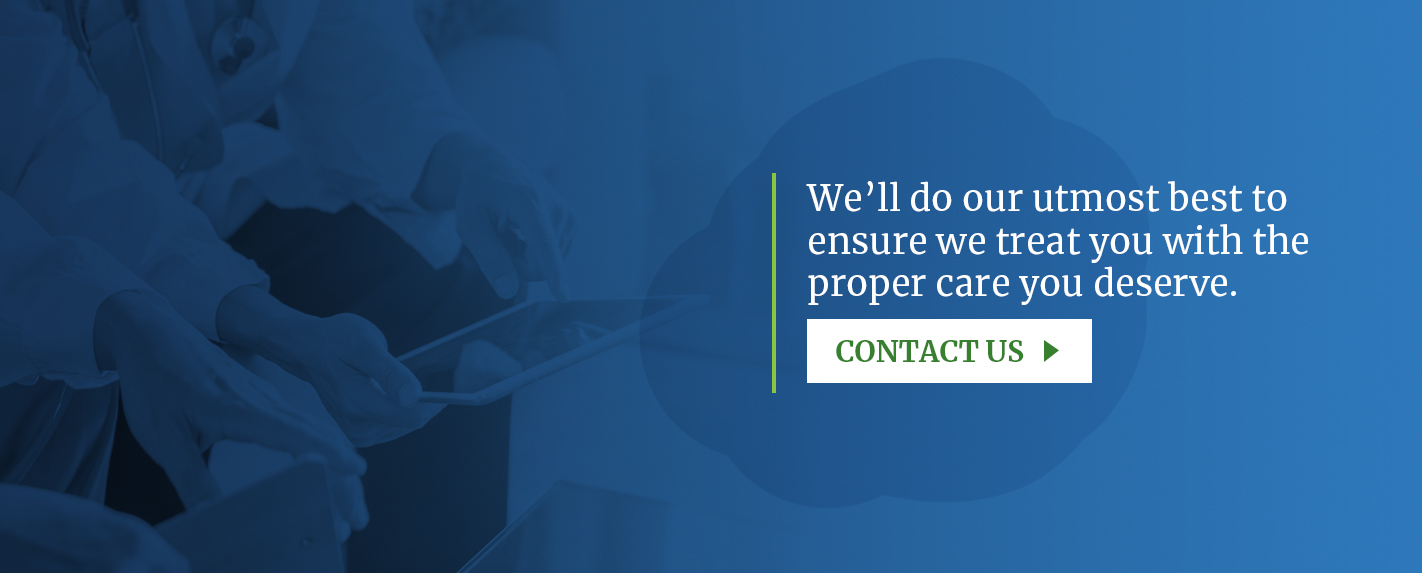This content was medically reviewed by Baher S. Yanni, MD, on October 14th, 2019.
When you’re experiencing pain in your upper back or neck that you haven’t experienced before, it could be a herniated disk. While it may worry you, it’s not an uncommon health issue as you get older. You may even develop the condition and not have any symptoms.
Are herniated discs common? The incidence rate of herniated discs is around five to 20 cases per 1,000 adult individuals yearly. They are often found in individuals in their 30s through their 50s, with a 2:1 male to female ratio.
Learn more about herniated discs, what could cause them, their symptoms and how they’re treated.
What Is a Herniated Disc?
A herniated disc is a common and potentially debilitating and painful condition. It’s also referred to as disc prolapse or slipped disc. Sometimes it can cause:
- Pain
- Weakness in the limbs
- Numbness
Herniated discs are usually an early stage of disc degeneration. You may not experience any pain at all, especially if the disc doesn’t press on any of your nerves. It depends on your particular case and the severity of your condition.
How Does a Disc Become Herniated?
When you experience a disc herniation, the cushion sitting between your spinal vertebra gets pushed outside its regular position. A herniated disc wouldn’t be an issue if it weren’t for your spinal nerves being so close to the edge of your cushioning discs.
Your spinal disc is a soft cushion sitting between each spinal vertebra. The spinal disc starts becoming more rigid as you age. It’s soft and elastic in younger individuals, but like with other body structures, it gradually loses its elasticity and becomes more susceptible to injury.
When your spinal disc starts becoming less elastic, it can rupture, and this can push a section of your spinal disc outside its regular boundary — thus becoming herniated. As a herniated disc starts bulging out from between your vertebrae, it can pinch your spinal cord and spinal nerves. There’s generally a little extra space around your spinal nerves and spinal cord, but if enough of the herniated disc pushes out of place, it may compress these structures.
What Are the Symptoms of Herniated Discs?
As the herniated disc becomes ruptured and pushes out, it can pinch the nerves. You can develop a herniated disc suddenly after an accident or a fall, or it can come on slowly with repetitive spine straining. Many people who develop herniated discs already have spinal stenosis, an issue causing narrowing of the space around your spinal nerves and spinal cord. With the occurrence of a herniated disc, the space for your nerves diminishes even further, causing nerve irritation.
When there’s compression of your spinal nerves and spinal cord, the nerves might not work properly and start sending abnormal signals — or no signals at all — to and from your brain.
Some common herniated disc symptoms are:
- Electric shock pain: Nerve pressure can lead to abnormal sensations, often felt like electric shock pains. When you have compression in your neck (cervical) regions, the shocks radiate down your arms. If it’s in your low back (lumbar) region, they go down your legs.
- Tingling and numbness: You might experience abnormal sensations like numbness, tingling or pins and needles. You may experience these symptoms in the same area as you do the painful electric shock sensations.
- Muscle weakness: Nerve irritation could interrupt your brain signals, causing muscle weakness. Your Metropolitan Pain & Spine Institute doctor can test for nerve irritation by examining your reflexes.
- Bowel or bladder problems: These symptoms could indicate a possible condition known as cauda equina syndrome. It’s a medical emergency, and you need to see your doctor immediately if you’re experiencing numbness around your genitals or are having issues with bowel movements or urinating.
These symptoms are all due to the nerve irritation from the herniated disc. The herniated disc presses against your nerves, which interferes with the pathway by which your brain sends signals to your extremities and receives them back.
What Are the Common Causes of Herniated Discs?
There are many herniated disc causes. However, it typically comes back to this — your intervertebral disc, which is the cushion positioned between your spine’s vertebrae, bulges, pushes out or even ruptures. This extremely contained disc begins taking up more room than it should, causing you a great deal of pain.
Some common causes of herniated discs include:
- Spinal wear and tear: Herniated disc pain is frequently due to everyday spinal wear and tear — or degeneration. Your back carries and helps distribute your weight. Your intervertebral discs are made for absorbing shock from movement like twisting, walking and bending. Since your discs work hard to help you move so well, over time they can get worn out. The annulus fibrous (the tough outer disc layer) can become weak and allow the nucleus pulposus (the jelly-like inner layer) to start pushing through, and this turns into a herniated disc.
- Injury: Injury, such as from a car accident, can lead to a herniated disc. The sudden jerking movement can put too much pressure on your disc, causing it to herniate. Twisting or incorrectly lifting a heavy object can herniate a disc as well.
- A combination of injury and degeneration: It might be wear and tear has weakened your intervertebral disc, making it more susceptible to herniation if you experience a traumatic event. Or, your disc may have weakened so much that something less traumatic could cause herniation, even something like sneezing. When you already have a weakened disc, it is susceptible to the sudden force sneezing creates.
- Obesity: If you’re overweight, you’re also at a higher risk of disc herniation because your discs need to support the extra weight. Too much weight, particularly around your midsection, can strain your lower back. A sedentary lifestyle and weak muscles might also contribute to the condition’s development.
- Motions and lifting: Certain movements might also lead to a herniated disc. The disc can slip out of place when you turn to lift an object or twist. Lifting a heavy, large object can also strain your back to the point a slipped disc develops. If you have an extremely physically demanding job requiring a lot of lifting, you might have an increased risk for disc herniation.
- Smoking: Nicotine limits spinal disc blood flow, making degeneration more severe and hampering healing. Degenerated discs are not as pliable as before and are more prone to tearing and cracking. This can cause disc herniation.
- Hereditary tendency: Disc degeneration and a hereditary disc degeneration tendency can increase your risk for herniation. A study showed a family with a history of lumbar herniated discs is a good indicator for future herniation.
- Frequent driving: Sitting in a seat for a long period, along with the car engine’s vibration can add pressure on your discs and spine.
- Sedentary lifestyle: Regularly exercising is essential in preventing a lot of health conditions, including herniated discs.
How Is a Herniated Disc Diagnosed?
It first starts with a herniated disc diagnosis. After talking with your doctor about your medical history and symptoms, they’ll perform a physical exam. This exam might include these following tests:
1. Straight Leg Raise (SLR) Test
The SLR test is an indicator of disc herniation in individuals under 35 years old. During this test, you’ll lie down on your back while the doctor lifts your affected leg carefully. Your knee remains straight. If you experience pain below your knee and down your leg, you likely have a herniated disc.
2. Neurological Examination
A neurological exam helps your doctor determine if you have any loss of sensation or muscle weakness. During the examination, they’ll:
- Detect loss of sensation by seeing if you can feel a slight touch on your foot and leg.
- Check your lower leg’s muscle strength by evaluating how you walk on both toes and heels. They may test other areas of your body as well.
- Test your ankle and knee reflexes. These might be absent in some cases if you have a compressed spinal nerve root.
3. Magnetic Resonance Imaging (MRI)
MRI scans provide the doctor with a clear image of your body’s soft tissues like your intervertebral discs. The doctor might order an MRI to help them learn which spinal nerves are being affected and confirm the diagnosis.
If you can’t tolerate an MRI, the doctor may order a computerized tomography (CT) scan instead. Or, they may order a CT myelogram.
What Are Herniated Disc Treatment Options?
Fortunately, many herniated discs don’t require surgery. But, a small percentage of herniated disc patients experience symptomatic or incapacitating and severe low back pain that can substantially impact daily life.
Conservative Treatments
The initial herniated disc treatment is typically non-surgical and conservative. Your doctor might prescribe bed rest, or they may advise you to keep a low, painless pace level for several days to several weeks, which can help reduce spinal nerve inflammation.
Your doctor may treat your herniated disc with nonsteroidal anti-inflammatory medicine if you are only experiencing mild to moderate pain. Another option is an epidural steroid injection using a spinal needle under the guidance of X-ray to direct the medicine to the precise level of disc herniation.
Your doctor might suggest physical therapy as well. The physical therapist will conduct an in-depth assessment, which, combined with the diagnosis the doctor gave, will advise a treatment plan designed especially for you. Therapy might include things like:
- Heat therapy
- Ice therapy
- Ultrasound
- Stretching exercises
- Gentle massage
- Pelvic traction
- Electrical muscle stimulation
You may also benefit from muscle relaxants and pain medication together with physical therapy.
Minimally Invasive Treatment
Another option for treating a herniated disc is an endoscopic discectomy procedure. This minimally invasive treatment could be the answer to ending your pain. In our facility, this is the least-invasive procedure we perform to remove herniated disc material. This procedure offers lower risks than traditional surgery and reduces your recovery time, allowing you to return to work within two or three weeks.
With endoscopic spine surgery, there is no bone removal, no muscle dissection and no need for a large incision. Therefore, you’ll be at less risk for infection, scarring, blood loss or complications due to anesthesia. An incision of 1/4 inch means your back muscles will be spared, your recovery time will be shorter and you’ll deal with fewer risks.
Conditions that endoscopic discectomy can treat include:
- Bulging disc
- Degenerative disc disease
- Spinal and foraminal stenosis
- Failed back surgery syndrome
- Sciatica pain
- Radicular pain
- Spondylolisthesis
- Arthritis of the vertebral bodies or facet
- Bone spurs
Surgical Treatment
Your doctor might suggest surgery if conservative treatments like medications and physical therapy aren’t reducing or eliminating the pain. They’ll talk with you about the different types of spine surgery available and will determine which procedure will be the best treatment option, depending on your specific case. Like with any surgery, they’ll factor in overall health, age and other issues into the consideration of surgery.
You should weigh the benefits of surgery carefully against the risks. While many individuals with herniated discs report substantial pain relief following surgery, there’s no guarantee it will help in every case.
Types of surgery for a herniated disc might include:
- Discectomy: The surgeon removes your intervertebral disc entirely or partially.
- Artificial disc surgery: The surgeon replaces your herniated or diseased lumbar disc with an artificial disc.
- Spinal fusion: The surgeon grafts a bone onto your spine to create a solid connection between two or more of your vertebrae. They may use instrumentation like rods and screws to provide extra spinal support.
You may be a good candidate for spinal surgery if:
- You develop progressive neurological deficits like numbness and/or leg weakness.
- You have leg and back pain that impairs your quality of life or limits normal activity.
- You find it difficult to stand or walk.
- You have a loss of normal bladder and bowel functions.
- You don’t find relief with physical therapy and medication.
- You’re in reasonably good health.
What Are Herniated Disc Prevention Tips?
Once you have gone through your herniated disc recovery time and have recovered from surgery, check with your doctor about resuming moderate herniated disc exercises The following herniated disc prevention tips may be helpful in avoiding herniated discs and low back pain:
- Perform crunches and other core/abdominal-muscle strengthening exercises for better spine stability. Stationary bicycling, brisk walking and swimming are good aerobic exercises that will typically not put extra stress on your back.
- Maintain proper posture when standing and sitting.
- Use proper moving and lifting techniques like squatting to lift a heavy item. Don’t bend and lift. Ask for help if something is too awkward or heavy.
- Avoid stressful situations if you can, since stress can cause muscle tension.
- Quit smoking since it’s a risk factor for hardening your arteries (atherosclerosis) which can lead to degenerative disc disorders and lower back pain.
Contact Metropolitan Pain & Spine Institute to Set up an Appointment
At Metropolitan Pain & Spine Institute, we perform the least-invasive spinal procedures. For instance, endoscopic spine procedures that help reduce or alleviate a painful condition like herniated disc and low spinal back pain are the least invasive procedures. They provide the smallest footprint on you, which is substantially less than even minimally invasive spinal surgery procedures. This leads to quicker recovery and a higher satisfaction rate.
We will get you back to work and life sooner. Since we offer the least-invasive procedure options for relieving your painful spinal condition, your recovery will be much quicker — usually, we can get you back to work within two to three days on average.
Our staff is friendly, knowledgeable, skilled and compassionate. We’ll do our utmost best to ensure we treat you with the proper care you deserve. Our patients are our priority. If you would like to learn more about how we can help ease your herniated disc, contact us today to set up your appointment and fill out our pain evaluation questionnaire.
This content was medically reviewed by Baher Yanni, M.D, on October 14th, 2019.
Sources:
https://www.ncbi.nlm.nih.gov/books/NBK441822/
https://www.aans.org/Patients/Neurosurgical-Conditions-and-Treatments/Herniated-Disc
https://orthoinfo.aaos.org/en/diseases–conditions/herniated-disk-in-the-lower-back/
https://www.ncbi.nlm.nih.gov/pubmed/11339862
https://medlineplus.gov/ency/article/000442.htm
https://www.spineuniverse.com/conditions/herniated-disc/causes-herniated-disc
https://www.healthline.com/health/herniated-disk
https://www.webmd.com/pain-management/what-is-a-herniated-cervical-disk#1
https://www.medicalnewstoday.com/articles/191979.php
https://www.spine-health.com/conditions/herniated-disc/lumbar-herniated-disc-causes-and-risk-factors
https://www.verywellhealth.com/herniated-disc-2548620
https://www.aafp.org/afp/2003/0515/p2195.html
https://my.clevelandclinic.org/health/diseases/12768-herniated-disc
https://www.mayoclinic.org/diseases-conditions/herniated-disk/symptoms-causes/syc-20354095
https://www.cedars-Metropolitan Pain & Spine Institutei.org/health-library/diseases-and-conditions/l/lumbar-disc-disease-herniated-disc.html
